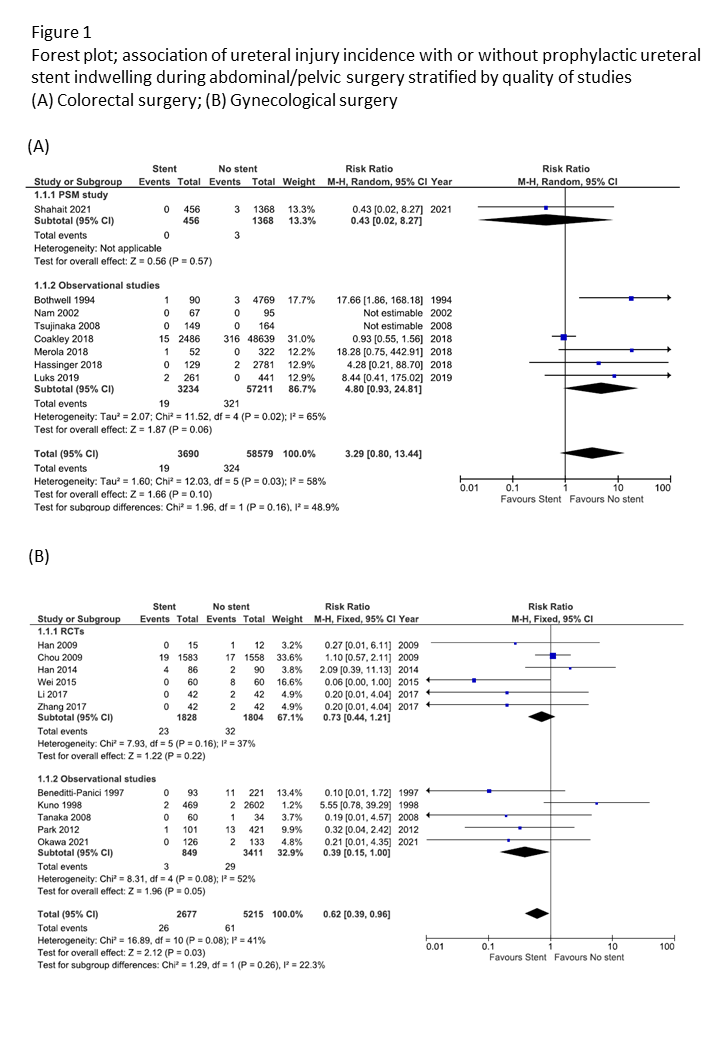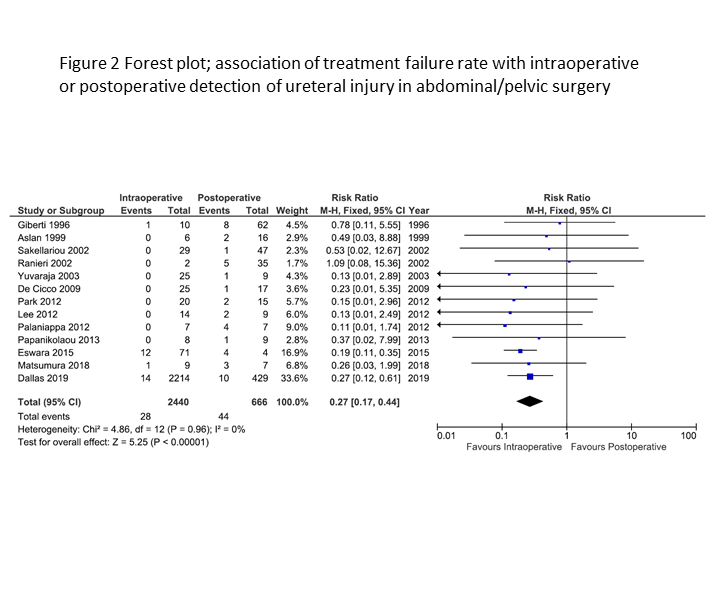Back
Poster, Podium & Video Sessions
Moderated Poster
MP25: Trauma/Reconstruction/Diversion: Ureter (including Pyeloplasty) and Bladder Reconstruction (including fistula), Augmentation, Substitution, Diversion
MP25-10: Prevention and Detection of Iatrogenic Ureteral Injury During Abdominal or Pelvic Surgery: A Systematic Review and Meta-analysis
Saturday, May 14, 2022
10:30 AM – 11:45 AM
Location: Room 228
Takafumi Yanagisawa*, Vienna, Austria, Keiichiro Mori, Tokyo, Japan, Reza Sari Motlagh, Tatsushi Kawada, Hadi Mostafaei, Fahad Quhal, Ekaterina Laukhtina, Pawel Rajwa, Frederik König, Maximilian Pallauf, Benjamin Pradere, Vienna, Austria, Jun Miki, Takahiro Kimura, Shin Egawa, Tokyo, Japan, Shahrokh F. Shariat, Vienna, Austria

Takafumi Yanagisawa, MD,PhD
Medical University of Vienna
Poster Presenter(s)
Introduction: Iatrogenic ureteral injury is rare but severe complication that can occur during abdominal or pelvic surgery, however robust data regarding optimal method for its prevention and management is still missing.
Methods: Multiple databases were searched for articles published before August 2021. Studies were deemed eligible if they evaluated the differences in the rate of ureteral injury between laparoscopic and open surgery, prophylactic ureteral stent indwelling or not and the differences in the rate of final treatment success between intraoperative and postoperative detection, in patients who underwent gynecological or colorectal surgery.
Results: Overall, 46 studies were eligible for this meta-analysis, comprising 491,519 patients for incidence analysis and 3,186 ureteral injuries for treatment outcome analysis. Pooled ureteral injury rate was 0.356% in colectomy and 0.334% in hysterectomy. Compared to open surgery, laparoscopic surgery was associated with a higher incidence of ureteral injury in hysterectomy (pooled risk ratio [RR]; 2.37, 95% Confidence Intervals [CI]; 1.84-3.06), but not in colectomy (pooled RR; 1.26, 95% CI; 0.77-2.06). Prophylactic ureteral stent indwelling was associated with a lower incidence of ureteral injury in gynecological surgery (pooled RR; 0.62, 95%CI; 0.39-0.96), but not in colorectal surgery (pooled RR; 3.29, 95%CI; 0.80-13.44). Intraoperative detection of ureteral injury was associated with higher rate of treatment success compared to postoperative detection (pooled RR; 0.24, 95%CI; 0.14-0.40).
Conclusions: Prophylactic ureteral stent indwelling can help not only detect the ureter intraoperatively, but also lessen the rate of ureteral injury in gynecological surgery. Furthermore, our analyses suggest that intraoperative detection of ureteral injury during abdominal/pelvic surgery led to higher success rate after repair surgery.
Source of Funding: None.


Methods: Multiple databases were searched for articles published before August 2021. Studies were deemed eligible if they evaluated the differences in the rate of ureteral injury between laparoscopic and open surgery, prophylactic ureteral stent indwelling or not and the differences in the rate of final treatment success between intraoperative and postoperative detection, in patients who underwent gynecological or colorectal surgery.
Results: Overall, 46 studies were eligible for this meta-analysis, comprising 491,519 patients for incidence analysis and 3,186 ureteral injuries for treatment outcome analysis. Pooled ureteral injury rate was 0.356% in colectomy and 0.334% in hysterectomy. Compared to open surgery, laparoscopic surgery was associated with a higher incidence of ureteral injury in hysterectomy (pooled risk ratio [RR]; 2.37, 95% Confidence Intervals [CI]; 1.84-3.06), but not in colectomy (pooled RR; 1.26, 95% CI; 0.77-2.06). Prophylactic ureteral stent indwelling was associated with a lower incidence of ureteral injury in gynecological surgery (pooled RR; 0.62, 95%CI; 0.39-0.96), but not in colorectal surgery (pooled RR; 3.29, 95%CI; 0.80-13.44). Intraoperative detection of ureteral injury was associated with higher rate of treatment success compared to postoperative detection (pooled RR; 0.24, 95%CI; 0.14-0.40).
Conclusions: Prophylactic ureteral stent indwelling can help not only detect the ureter intraoperatively, but also lessen the rate of ureteral injury in gynecological surgery. Furthermore, our analyses suggest that intraoperative detection of ureteral injury during abdominal/pelvic surgery led to higher success rate after repair surgery.
Source of Funding: None.

.jpg)
.jpg)